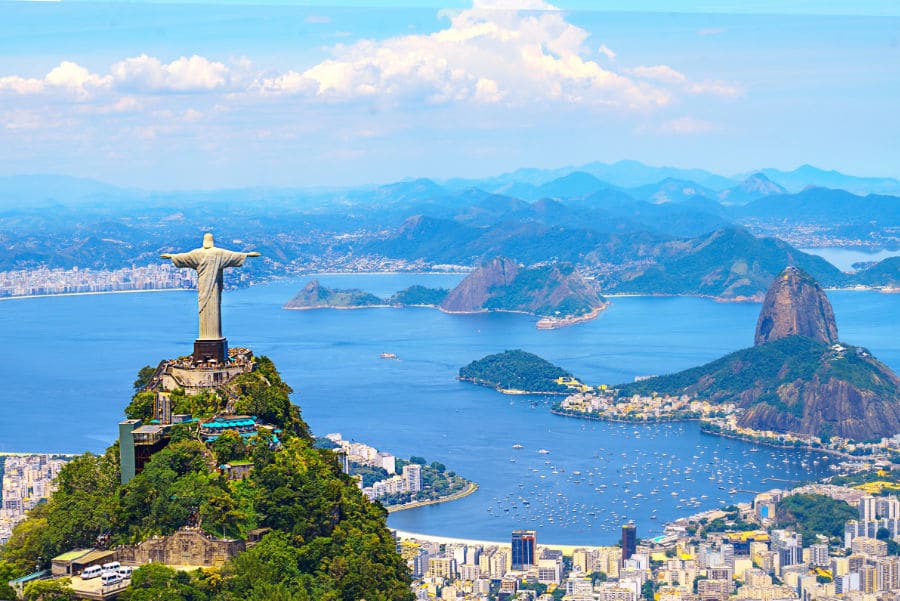Ricardo Cano, Director of EVE Museums and Innovation, shares his insight into the specificities of the Latin American market for international travelling exhibits. This article is based on a full report on touring in Latin America which explores the area, introduces key stakeholders and provides useful tips for the promotion of international exhibitions in the region. The full report is available to members.
The countries which present the most dynamic markets for the production and installation of travelling and temporary exhibitions in Latin America are those that boast the largest numbers of private museums, with a dynamic landscape of public institutions, and with proportional interest from their audiences for temporary exhibitions.
Rank Country Number of Museums
1
Brazil
3,818 museums
2
Mexico
1,263 museums
3
Argentina
1,017 museums
4
Colombia
755 museums
5
Peru
371 museums
Most of the travelling and temporary exhibitions presented in Latin America are held in museums and cultural centre spaces. The number of exhibitions that are presented, as well as the number of visitors to these exhibitions, are correlated with the number of museums in the country.
In another way, attendance to this type of exhibition is not directly linked to the number of tourists visiting each of these countries. Cancun in Mexico, for example, welcomed a record number of 9 million tourists in 2018, well above the rest of the continent, and yet no increase in visits to the Great Museum of the Mayan World of Merida in the Yucatan Peninsula was recorded in the period.
Private museums tend to present more exhibitions than public institutions.
Countries and institutions with successful exhibitions
In the five countries highlighted above, private museums tend to present more exhibitions than public institutions. They are also the most visited cultural institutions in Latin America. The movements of exhibitions also align with the museum’s ranking in visitor numbers, with the most visited museums also being the most active when it comes to presenting travelling exhibitions. Amongst these institutions, the top five in terms of visitor numbers for 2018 were:
Rank Museum Location Visitors
1
Museo Centro Cultural Banco do Brasil
Sao Paulo, Brazil
1,500.000 visitors/year
2
Museo Fundación CCBB
Brasília, Brazil
1,250.000 visitors/year
3
Museo Complexo Cultural de Brasilia
Brasília, Brazil
950,000 visitors/year
4
Museo Instituto Tomie Otake
Sao Paulo, Brazil
900,000 visitors/year
The numbers reveal that the most visited venues are private institutions; more specifically, they are private foundations.
Furthermore, the most visited exhibitions in Latin America coincide with the figures of the most visited museums. The most visited exhibitions in Latin America in 2018 were predominantly presented in private foundations, with content mostly related to art. The top ten most visited exhibitions were:
Rank Exhibition Museum Visitors in 2018
1
Sensitive Buildings
Museo Centro Cultural Banco do Brasil
293,000 visitors
2
Erwin Wurm: The body as the house
Museo Centro Cultural Banco do Brasil
291,000 visitors
3
Jean Michel Basquiat
Museo Centro Cultural Banco do Brasil
283,000 visitors
4
Exposición Electronic International Language Festival
Museo Centro Cultural Banco do Brasil
265,000 visitors
5
Ex Africa
Museo Centro Cultural Banco do Brasil
260,000 visitors
6
Julio Le Parc: from shape to action
Instituto Tomie Otake
212,000 visitors
7
Modern Masterpieces
Instituto Tomie Otake
200,000 visitors
8
Amelia Toledo remembered
Museo Centro Cultural Banco do Brasil
171,000 visitors
9
100 years of Athos Bulcao
Museo Centro Cultural Banco do Brasil
166,000 visitors
10
Football museum in the área
Museo Centro Cultural Banco do Brasil
161,000 visitors
Entry to the travelling exhibitions presented in the four Centro do Brasil venues mentioned above was free. Every year, the cultural centres of the Banco do Brazil are listed in the top ranking of the most visited institutions in Latin America, and they lead by far. This very successful institution, which boasts an impressive track record of successful presentations of international touring exhibitions, is a key example of an entity that has the capacity to hire travelling exhibitions in Latin America. Foundations related to banks and private multinational companies, in particular from the banking and telecommunications industries, represent the most active and successful stakeholders in the hosting of major exhibitions in Latin America.
In the light of visitor data and exhibitions’ success, the touring exhibitions market appears particularly concentrated in these five countries: Brazil, Peru, Mexico, Colombia and Argentina.
The touring exhibitions market appears particularly concentrated in these five countries, Brazil, Peru, Mexico, Colombia and Argentina.
Organisations involved in travelling exhibitions
Public institutions, whether ministries or national or local entities connected to governments in the main countries of Latin America, have less and less room to manoeuvre with regard to contracting exhibitions. This is notably due to a progressive decrease in budgets dedicated to the promotion of culture, and to a substantial reduction in the outsourcing of exhibitions. In certain contexts, a collaboration between a public administration and a carefully selected private entity can be created. With this approach, partnerships are set whereby the government gives access to exhibition spaces (a public museum, for example), while the private entities (usually foundations and large companies) bear the exhibitions’ production and installation expenses. For example, the Parque Jurásico exhibition, which was presented in the Bicentennial Park of Mexico City in 2019, was financed by the Discovery Channel.
Currently, the large greatest opportunities niche for the hire of exhibitions comes mainly from the greatest opportunities for the hire of exhibitions come mainly from private entities, almost always foundations created by large companies (especially organisations from the banking and telecommunications industries), which, through their Corporate Social Responsibility strategies, demonstrate great interest in the promotion of cultural events, including the production and installation of temporary exhibitions.
Some private foundations in Latin America do actually own museums and schedule temporary exhibitions, such as the Fundación Carlos Slim with the Museo Soumaya, and the Fundación Júmex with the Museo Júmex in Mexico City, both of which are very active museums. The Museo Júmex notably presented the temporary exhibition entitled Appearance Stripped Bare: Desire and The Object in the Work of Marcel Duchamp and Jeff Koons, Even in 2019. The National Museum of Anthropology of Mexico has a solid schedule of annual temporary exhibitions, almost all financed by private stakeholders. For instance, the Viajeros en el Tiempo (Time Travellers) temporary exhibition it presented in 2019 was fully funded by the company IBM Watson. The most visited non-artistic exhibition of Mexico in 2018 was América, tierra de jinetes. Del charro al gaucho, siglos XIX al XXI (America, land of the cowboy; from Charro to Gaucho, 19th–20th century) at the Palacio de Artes Iturbide, owned by the Fundación Banco Citibanamex.
One of the best kept secrets in this foundation sector is the enormous development of corporate foundations in some Latin American countries. These organisations are dedicated to cultural dissemination in the region and contribute significantly to the development of a dynamic exhibitions landscape in Latin America.
Where exhibits come from
As discussed with the ranking of the most visited exhibitions in Mercosur, most of the exhibitions are produced for large museums and major cultural centres. They are mostly sponsored by private entities and sometimes developed in partnership with the government – a process which is more common in Colombia than in other countries.
Beyond these major productions, there is also a category of more modest travelling exhibitions, which are usually hired for an average of six months and which welcome an average number of approximately 90,000 visitors. These exhibitions are presented in important museums and are most often dedicated to science and technology. At their origin, these exhibitions are either travelling exhibitions rented from large museums and organisations related to museums or they are hired from private companies specialised in travelling exhibitions. These exhibition companies organise tours within countries or between different countries, in direct contact with contracting organisations. These companies, such as Imagine Exhibitions and Exhibits Development Group, are mostly based in the United States and Canada. Only a few private organisations dedicated to the production and installation of touring exhibitions are actually based in Latin America, such as Coolture Exhibitions and Expomus.
Positioning a brand is not a simple task, but contacting potential clients in a personal way is not so complicated and can be very effective.
The content of some of these exhibitions is provided without local adaptations. Some of them arrive from the United States and Canada without a Spanish translation, leaving the host institution in charge of translation management and costs. The average cost of hiring an exhibition of this type, which usually covers 800 – 1,200 sqm, is in the region of USD 180,000 including installation and excluding transportation and space adaptation costs.
Because of their inability to meet the costs involved in hiring external exhibitions, many public museums increasingly consider producing their own exhibitions exclusively, and many already do. Home exhibitions enable the creation of very modest productions in most cases, and allow the museum to focus on a theme which is of very specific interest for the local community.
Occasionally, opportunities arise to develop exceptional projects, such as Guillermo del Toro’s exhibition at the Museum of Contemporary Art of the University of Guadalajara in Mexico, At Home With Monsters, which was met with great public success during its four-month run. This exhibition was made possible thanks to Mr. del Toro’s particular commitment and relationship with the university.
How to succeed in the Latin American market
To increase the chance of success, organisations that want to enter the Latin American market should consider collaborating with a strategic partner who can communicate in both Spanish and English, is physically present in the LatAm market, and has thorough expertise in international projects management, combining an international point of view with knowledge of the Latin American market. Ideally, the strategic partner is preferably based in a country where levels of museum production are optimal and competitively priced. Mexico and Brazil, for example, offer the possibility of giving access to partners that can collaborate on the development of large productions.
The Latino market is a complex market with really unpredictable responses to the implementation of commercial marketing strategies, and therefore unpredictable return on investment. Experience has shown that classic promotional actions, including the organisation of congresses for science museums, which has already been tried by international producers, can lead to modest results, well below expectations. The Latino market is influenced by direct personal-professional relationships. Positioning a brand is not a simple task, but contacting potential clients in a personal way is not so complicated and can be very effective.
Full report for members
Contact Teo at contact@teo-exhibitions.com to request your copy of the full report for Exposiciones Itinerantes: an introduction to touring in Latin America.
Contact Teo
Sources
EVE Museos e Innovación – Museum Visitors Ranking of 2018: https://evemuseografia.com/2019/07/31/ranking-mundial-de-visitantes-a-museos-en-2018/
Ibermuseos: http://www.ibermuseos.org
Travelling Exhibition Network: https://www.aam-us.org/professional-networks/traveling-exhibitions-network-ten/
About the authors & contributors
Ricardo Cano is a museum specialist, an exhibition designer, and an expert consultant for international museum projects, especially in Latin America. He is specialised in innovation and digital transformation for museums, with years of experience in the development of museum projects, with a focus on gallery and experience design, feasibility assessments, and creation and refurbishment of museums and exhibitions. His company, EVE Museums and Innovation, manages collections and content in permanent and temporary exhibitions in a creative and innovative way, and provides specialised training in museology, museum management, institution communication and technological innovation in museum exhibitions.



